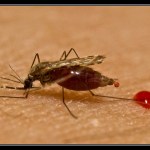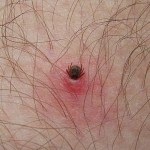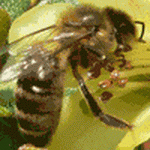bite
Mosquitoes. That's right, mosquitoes. As creepy little transmitters of diseases such as the current Zika virus epidemic (linked with causing the birth defect microencephaly), West Nile virus, malaria, chikungunya, and dengue fever, mosquitoes kill over 1 million people every year according to the World Health Organization.
This fascinating video from PBS shows how they suck your blood:
I am using insect repellent this summer after watching that video!
Testing the bite force of American cockroaches. Image from: Tom Weihmann | University of Cambridge
I'll admit I get a bit squeamish when I see a cockroach. However, after reading new research about the "ew" inspiring creatures, I have a bit more respect for them.
Not only can these bugs run vertically up walls, survive nuclear war and live without their head for weeks (thus I suggest squishing the whole body), new research published in PLOS ONE shows they have super-biting powers. The research team measured bite force using a sensor (shown in the image above).
The reason for…
Image of mosquito from http://bloodinurineandpainofca.wordpress.com/
Until now I thought I had come up with enough reasons to dislike mosquitoes, those tiny little blood sucking vectors of disease. With reports of the debilitating mosquito-borne virus chikungunya in the Americas (Carribean), I was ecstatic hear that researchers are working hard to find ways to control mosquito populations. As mentioned in a previous blog, only the females bite to obtain nourishment for developing eggs. According to the study authors, the female mosquito can double her own body weight after just one meal,…
In honor of the Discovery Channel's "Shark Week", check out these shark cams.
National Aquarium Reef Shark Cam:
Broadcast live streaming video on Ustream
SHARK FIN CAM: Video taken from a camera strapped to the dorsal fin of a shark:
Broadcast live streaming video on Ustream
If you have not yet tuned in to Discovery Channel, there are still a few days left of shark week!
Image of a tick stealing a meal from: www2.outdoorchannel.com
Ticks are blood-sucking arthropods that can act as vectors for various diseases in both animals and humans. A recent article published in Frontiers in Zoology summarizes findings that suggest ticks may also be considered venomous ectoparasites. For example, Ixodes holocyclus is a species of Australian tick whose saliva can induce paralysis in humans and animals. According to the new article, about 8% of known tick species can induce paralysis. Ornithodoros savignyi ticks even secrete a lethal…
Just in case you have not seen this viral YouTube video of the family cat saving a boy from a vicious dog attack, I have embedded it below. I think this kitty deserves a nice fresh fish for dinner...every day.
An article was posted today in NBCNews featuring the heroics of other house cats.
Here is one of my favorites:
Image of a clawless house cat named Jack that chased a bear up a tree. Image from NBC News: http://www.today.com/pets/good-kitty-these-6-hero-cats-saved-humans-the…
These brave felines must really believe they have 9 lives!!
You can check out the rest of these heroic…
Image of a Chinese red-headed centipede from Wikimedia Commons.
Researchers from the Chinese Academy of Sciences and The University of Queensland have discovered a venom from centipedes capable of blocking pain more effectively than morphine!
According to the study authors, centipedes have appeared in the fossil records as far back as 430 million years. They are also one of the first land-dwelling creatures to use venom to incapacitate their prey as shown in the image above of a Chinese red-headed centipede (Scolopendra subspinipes mutilansis) snacking on a roach. The venom is…
Image from: http://Phys.Org
Not only do bees sting, but they also bite victims that are too small for stingers (ex: wax moth larva that invade the beehive and eat pollen) and paralyze them for up to nine minutes by secreting 2-heptanone into the wound. This paralysis gives the bees time to remove the invaders from the beehive. Dr. Papachristoforou and his team at Aristotle University of Thessaloniki in Greece discovered the paralyzing effects of the honeybee bite while studying wax moth larvae that invade the beehives. Their data suggest that this chemical may be an effective…
Our recent coverage of the Cracked story "The 5 Most Horrifying Bugs in the World" made reference to the Schmidt Sting Pain Index, something we felt the need to explore further. Apparently Dr. Justin O Schmidt, an entomologist recently retired from the U.S. Department of Agriculture's Tucson Carl Hayden Bee Research Center, felt the need to create a ranking system for insect stings. More specifically Hymenoptera stings, the order of insects that includes bees, wasps, ants and sawflies. Typically the "research" was conducted on himself and frequently required provoking the little guys to…




